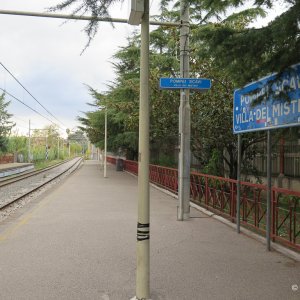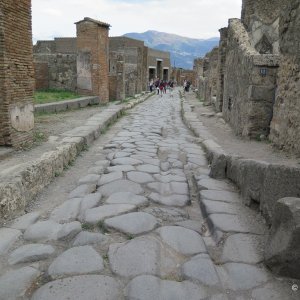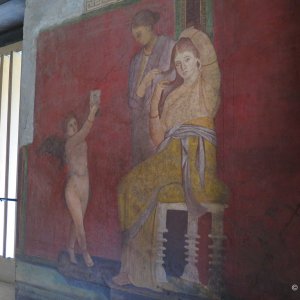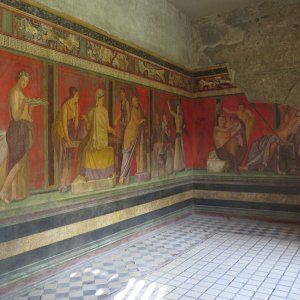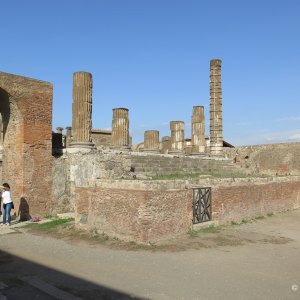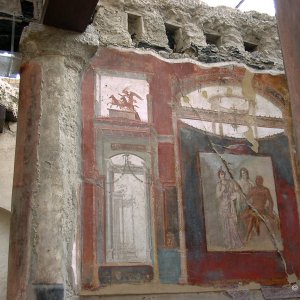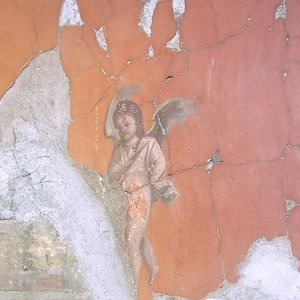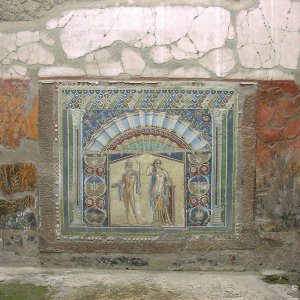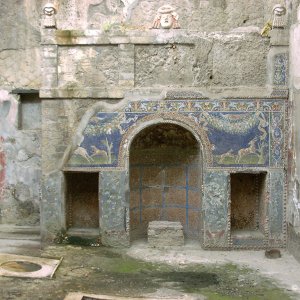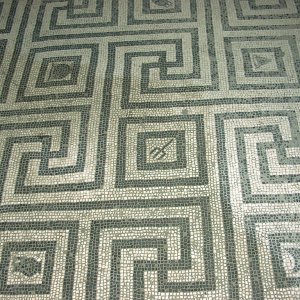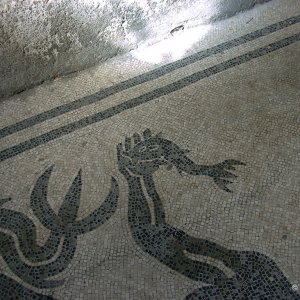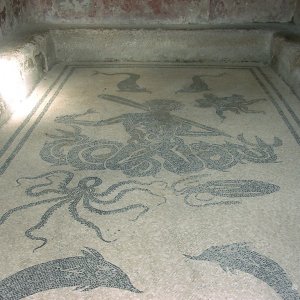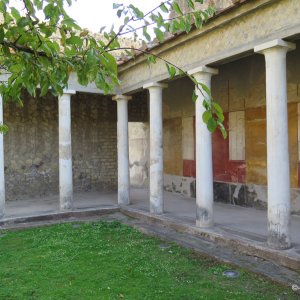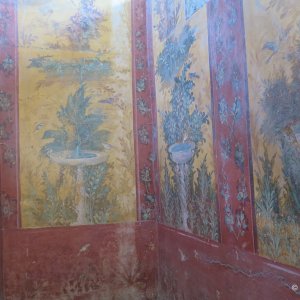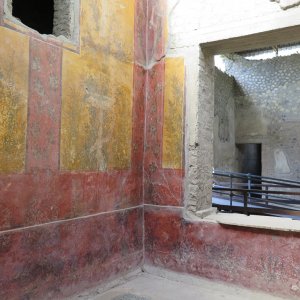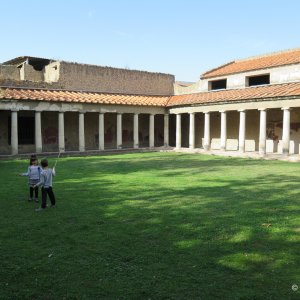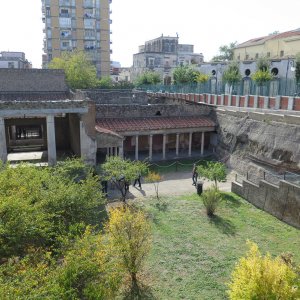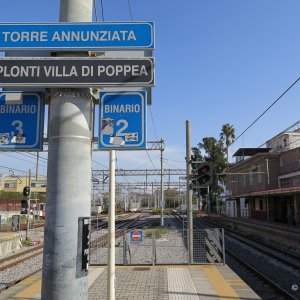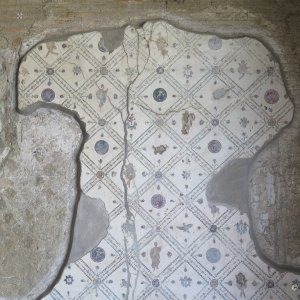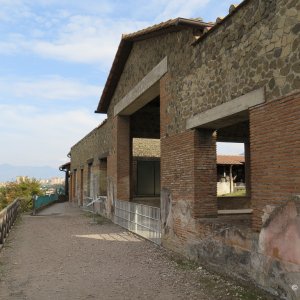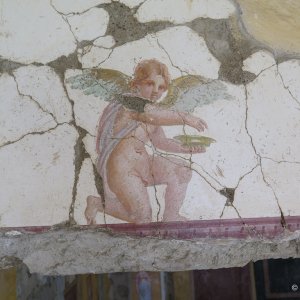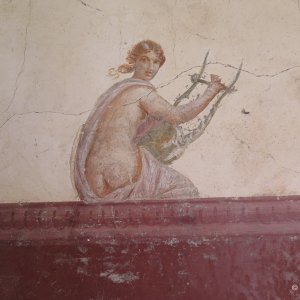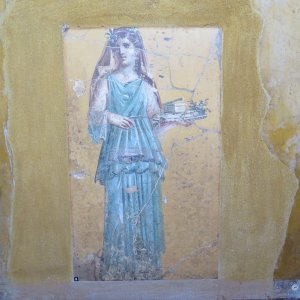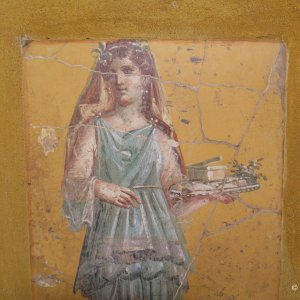Mount Vesuvius is an active volcano, south of Naples, near the coast. On 24 August 79 AD Mount Vesuvius erupted covering nearby towns with 13 - 20 feet of ash. Several of these towns, on the south side of Vesuvius, have been excavated and are open to the public. These archaeological sites give you a unique look at life in the 1st century AD.
Pompeii and Herculaneum are the best known, but smaller sites like Oplontis and Stabia are interesting too. If you have time for only one site, go to Pompeii. Plan to spend several hours there - it is magnificent. We have been there three times and I would happily return. The Archaeological Museum in Naples has many artefacts from these sites.
This is a very populated area and the sites are surrounded by busy residential areas. Herculaneum, Oplontis and Pompeii are easily reached by the Circumvesuviana train line that runs from Naples to Sorrento (around Vesuvius). Stabia can be reached by car or taxi.
Pompeii
The city of Pompeii, founded in the 7th - 6th century BC, became a Roman colony in 80 BC. On 24 August 79 AD Mount Vesuvius erupted, covering nearby towns of Pompeii and Herculaneum with 13 - 20 feet of ash. At the time of its destruction the population of Pompeii was 11,000 and it was a busy and thriving city with a port, an amphitheater and a water system. In 1599 the well preserved remains of Pompeii were discovered under the ash.
The ruins of Pompeii give a unique look at life in Ancient Roman times. The city was "frozen in time" because of the volcanic eruption. When the ash was removed, the city remained as it was in 79AD. Many streets and buildings remain. The amphitheater is well preserved. They were able to see how people looked as they died by using concrete to fill in the spaces left by bodies in the ash. Some of these casts are on display in Pompeii and some in the museum in Naples. Pompeii is one of the most popular tourist attractions in Italy.
Location: Italy - Campania & Amalfi Coast - Naples - Pompei
Note that Pompeii with two "i" is the name of the ancient town. Pompei with one "i" is the name of the modern town. The ancient town is also called Pompei Scavi.
How to Get There: The best way to get to Pompeii is by train, the Circumvesuviana (around Vesuvius) that runs from Naples to Sorrento. The train stops at the main entrance (Porta Marina or Piazza Esedra) - the stop is "Pompei Scavi" or "Pompei Scavi - Villa dei Misteri". Pompeii is easiest to reach from Naples or Sorrento, by the Circumvesuviana.
It is also possible to get there from the Amalfi Coast by bus to Sorrento and then the Circumvesuviana. There is a special tourist bus that runs from the Amalfi Coast to Pompeii.
If you drive, there is a large parking lot at Pompeii.
Website: Pompeii Sites

Mt Vesuvius, the volcano that destroyed Pompeii, as seen from Pompeii.
Google Map

More Photos
Herculaneum
Herculaneum (Scavi di Ercolano) was an ancient Roman town destroyed by volcanic flows in 79 AD from Mount Vesuvius, the same eruption that covered nearby Pompeii. Herculaneum was a smaller town with a wealthier population than Pompeii. The buried city was discovered in the 18th century. The modern town of Ercolano is built up around the ancient town, much of which has been preserved.
Location: Italy - Campania & Amalfi Coast - Naples - Ercolano
How to Get There: It is easiest to reach Herculaneum by train from Naples or Sorrento (Circumvesuviana, station - "Ercolano Scavi"). It is a short walk from the station to the site.
Website: Herculaneum Conservation Project

Herculaneum, an ancient city dug out from the volcano ash, smaller than Pompeii but better preserved.
Google Map

 goo.gl
goo.gl
More Photos
Oplontis
Oplontis was a suburb of Pompeii. The modern town is now called Torre Annunziata. What remains of Oplontis is the Villa of Poppea (Villa di Poppea), a luxurious residential complex from mid 1st century BC. It possibly belonged to Nero's second wife (Poppaea Sabina). The villa is 10 meters below the current street level. It is large and you can explore it on your own.
Location: Italy - Campania & Amalfi Coast - Naples - Torre Annunziata
It is easiest to reach Oplontis by train from Naples or Sorrento (Circumvesuviana - station "Torre Annunziata, Oplonti Villa di Poppea").
Website: Pompeii Sites

Frescoes.
Google Map

 goo.gl
goo.gl
More Photos
Stabia
Stabia was a town in the 8th century BC with many residential villas. One of the best villas, Villa San Marco, has been excavated and is open to the public. Villa Arianna, also open to the public, is the oldest villa. It is located nearby, not on the same site. Villa San Marco has many beautiful frescoes and it is well worth seeking out this site.
Location: Italy - Campania & Amalfi Coast - Naples - Castellammare di Stabia
This site is not easy to reach without a car. We drove here from the Amalfi Coast.
Website: Pompeii Sites

Stabia - Villa San Marco
Google Map

 goo.gl
goo.gl
More Photos
Pompeii and Herculaneum are the best known, but smaller sites like Oplontis and Stabia are interesting too. If you have time for only one site, go to Pompeii. Plan to spend several hours there - it is magnificent. We have been there three times and I would happily return. The Archaeological Museum in Naples has many artefacts from these sites.
This is a very populated area and the sites are surrounded by busy residential areas. Herculaneum, Oplontis and Pompeii are easily reached by the Circumvesuviana train line that runs from Naples to Sorrento (around Vesuvius). Stabia can be reached by car or taxi.
Pompeii
The city of Pompeii, founded in the 7th - 6th century BC, became a Roman colony in 80 BC. On 24 August 79 AD Mount Vesuvius erupted, covering nearby towns of Pompeii and Herculaneum with 13 - 20 feet of ash. At the time of its destruction the population of Pompeii was 11,000 and it was a busy and thriving city with a port, an amphitheater and a water system. In 1599 the well preserved remains of Pompeii were discovered under the ash.
The ruins of Pompeii give a unique look at life in Ancient Roman times. The city was "frozen in time" because of the volcanic eruption. When the ash was removed, the city remained as it was in 79AD. Many streets and buildings remain. The amphitheater is well preserved. They were able to see how people looked as they died by using concrete to fill in the spaces left by bodies in the ash. Some of these casts are on display in Pompeii and some in the museum in Naples. Pompeii is one of the most popular tourist attractions in Italy.
Location: Italy - Campania & Amalfi Coast - Naples - Pompei
Note that Pompeii with two "i" is the name of the ancient town. Pompei with one "i" is the name of the modern town. The ancient town is also called Pompei Scavi.
How to Get There: The best way to get to Pompeii is by train, the Circumvesuviana (around Vesuvius) that runs from Naples to Sorrento. The train stops at the main entrance (Porta Marina or Piazza Esedra) - the stop is "Pompei Scavi" or "Pompei Scavi - Villa dei Misteri". Pompeii is easiest to reach from Naples or Sorrento, by the Circumvesuviana.
It is also possible to get there from the Amalfi Coast by bus to Sorrento and then the Circumvesuviana. There is a special tourist bus that runs from the Amalfi Coast to Pompeii.
If you drive, there is a large parking lot at Pompeii.
Website: Pompeii Sites

Mt Vesuvius, the volcano that destroyed Pompeii, as seen from Pompeii.
Google Map
More Photos
Campania, Pompeii
- Pauline
- 23
On 24 August 79 AD Mount Vesuvius erupted, covering Pompeii with 13 - 20 feet of ash.
Herculaneum
Herculaneum (Scavi di Ercolano) was an ancient Roman town destroyed by volcanic flows in 79 AD from Mount Vesuvius, the same eruption that covered nearby Pompeii. Herculaneum was a smaller town with a wealthier population than Pompeii. The buried city was discovered in the 18th century. The modern town of Ercolano is built up around the ancient town, much of which has been preserved.
Location: Italy - Campania & Amalfi Coast - Naples - Ercolano
How to Get There: It is easiest to reach Herculaneum by train from Naples or Sorrento (Circumvesuviana, station - "Ercolano Scavi"). It is a short walk from the station to the site.
Website: Herculaneum Conservation Project

Herculaneum, an ancient city dug out from the volcano ash, smaller than Pompeii but better preserved.
Google Map
Archaeological Park of Herculaneum · Corso Resina, 187, 80056 Ercolano NA, Italy
★★★★★ · Archaeological museum
More Photos
Campania, Herculaneum
- Pauline
- 12
Ancient Roman town destroyed by volcanic flows in 79 AD from Mount Vesuvius.
Oplontis
Oplontis was a suburb of Pompeii. The modern town is now called Torre Annunziata. What remains of Oplontis is the Villa of Poppea (Villa di Poppea), a luxurious residential complex from mid 1st century BC. It possibly belonged to Nero's second wife (Poppaea Sabina). The villa is 10 meters below the current street level. It is large and you can explore it on your own.
Location: Italy - Campania & Amalfi Coast - Naples - Torre Annunziata
It is easiest to reach Oplontis by train from Naples or Sorrento (Circumvesuviana - station "Torre Annunziata, Oplonti Villa di Poppea").
Website: Pompeii Sites

Frescoes.
Google Map
Scavi di Oplontis - Villa Poppea · Via Sepolcri, 80058 Torre Annunziata NA, Italy
★★★★★ · Archaeological museum
More Photos
Campania, Oplontis - Villa of Poppea
- Pauline
- 8
A luxurious residential complex from mid 1st century BC.
Stabia
Stabia was a town in the 8th century BC with many residential villas. One of the best villas, Villa San Marco, has been excavated and is open to the public. Villa Arianna, also open to the public, is the oldest villa. It is located nearby, not on the same site. Villa San Marco has many beautiful frescoes and it is well worth seeking out this site.
Location: Italy - Campania & Amalfi Coast - Naples - Castellammare di Stabia
This site is not easy to reach without a car. We drove here from the Amalfi Coast.
Website: Pompeii Sites

Stabia - Villa San Marco
Google Map
Scavi di Stabia - Villa San Marco · Passeggiata Archeologica, 80053 Castellammare di Stabia NA, Italy
★★★★★ · Archaeological museum
More Photos
Campania, Stabia - Villa San Marco
- Pauline
- 23
Stabia was a town in the 8th century BC with many residential villas.
Last edited:

